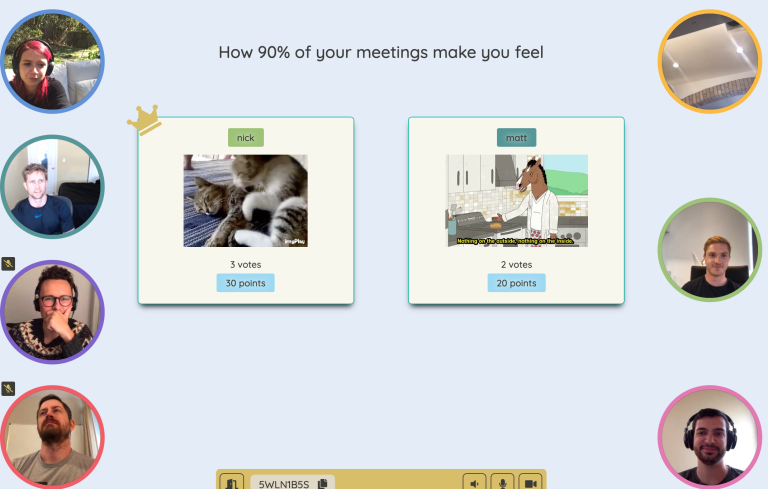17 Work Habits All Teams Should Adopt From Remote Work
For teams around the world, 2020 fundamentally changed perspectives on how (and where) work can be accomplished.
No matter what the future looks like, the skills remote work teaches will be useful for years to come, as more organizations go fully remote, adopt a hybrid model, or teams become globally distributed.
In this article, we’ve rounded up some of the best remote work practices based on our long-standing experiences as a ‘pre-pandemic’ fully distributed company. These are habits and skills that teams should hang onto, regardless of whether you work from home, from an office, with a globally distributed team or a hybrid team. So make sure to bookmark this resource!
Why keeping (some) remote work habits is a good thing
The idea of working from home may not be for everyone, but remote work as a concept has a lot of great benefits to it:
- 🏋🏽 Increased productivity: Almost all employees (94%) report equal or greater productivity when working remotely compared to when they’re in the office.
- 😌 Better work life balance: The majority of people (79%) cite flexibility and not having a commute as the top benefit of remote work.
- 🙌 People really like it: Nearly everyone (97.6%) wants to continue working remotely – at least some of the time – for the rest of their career.
So keeping the best habits and practices from remote working is not about being an ardent remote work advocate.
It’s just about taking the habits and practices that produce great results and seeing how they fit into any kind of work. James Clear, author of Atomic Habits says that making habits stick is all about making them obvious, attractive, easy, and satisfying!
So if you see a colleague putting one of the great remote work habits we mention into action, give them some kudos to help make that practice attractive and satisfying for them and for others. And change your working systems to make adhering to habits easy and obvious.
Common remote work habits to keep no matter where you work
Here are the 17 remote work techniques, habits, and behaviours we think all teams should keep no matter how or where you work in the future.
1. Asking for input in public channels❓
The habit of asking for input before making decisions – and asking for feedback after the fact – enhances transparency within your team and encourages a greater diversity of feedback. And the more input you get, the more data you have available to make decisions with.
Unlike in an office where you might have only got input from the people in the room, public channels on Slack and MS Teams allow everyone the opportunity to pitch in.
In that sense, asking for feedback via Slack or Teams is more inclusive and allows introverts and extroverts alike an opportunity to add more thoughtful input.
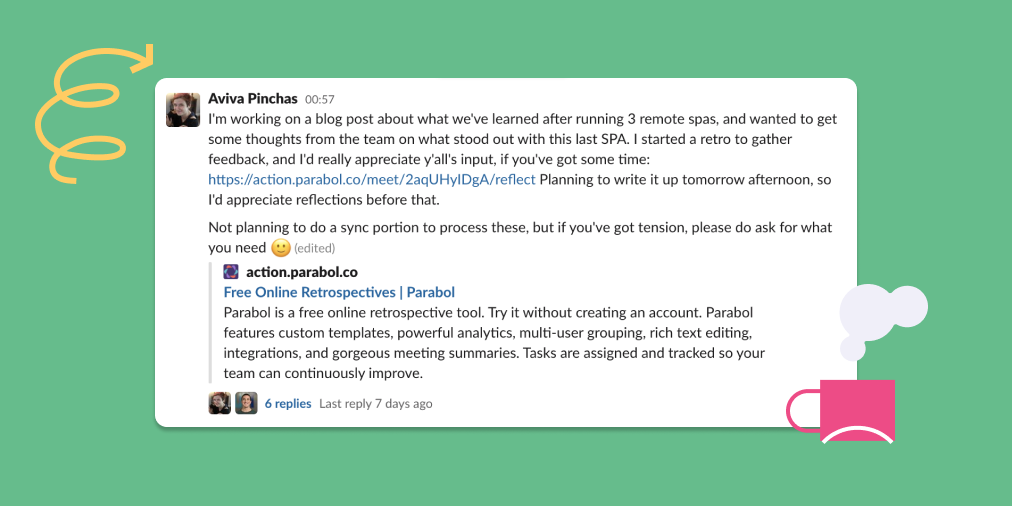 An example of Aviva from the Parabol team requesting input from the rest of the team. Sometimes we collect input in Notion or Slack. Other times we use Parabol to process input, particularly when we want it to stay anonymous.
An example of Aviva from the Parabol team requesting input from the rest of the team. Sometimes we collect input in Notion or Slack. Other times we use Parabol to process input, particularly when we want it to stay anonymous.
2. Being time zone sensitive ⏰
Collaborating with people in different time zones means you might only have a couple of hours cross-over for face-to-face contact. And in fully distributed organizations with teams spread around the world, the challenge can be acute. If your organization transitioned to a remote-first operating model during the 2020 pandemic, time zones might become more of a problem as people start to work from different places as nomads.
Being time zone sensitive means finding the most convenient hours for synchronous meetings across time zones, leaning on async work practices as much as possible (more on that later), and giving everyone equal opportunities to contribute feedback or input on documents or proposals.
It can be very easy, for example, for teams to discuss and more-or-less come to decisions while some team members are sleeping, so try being more inclusive by giving a 24 hour grace period to collect comments on proposals, ideas, or other pieces of work.
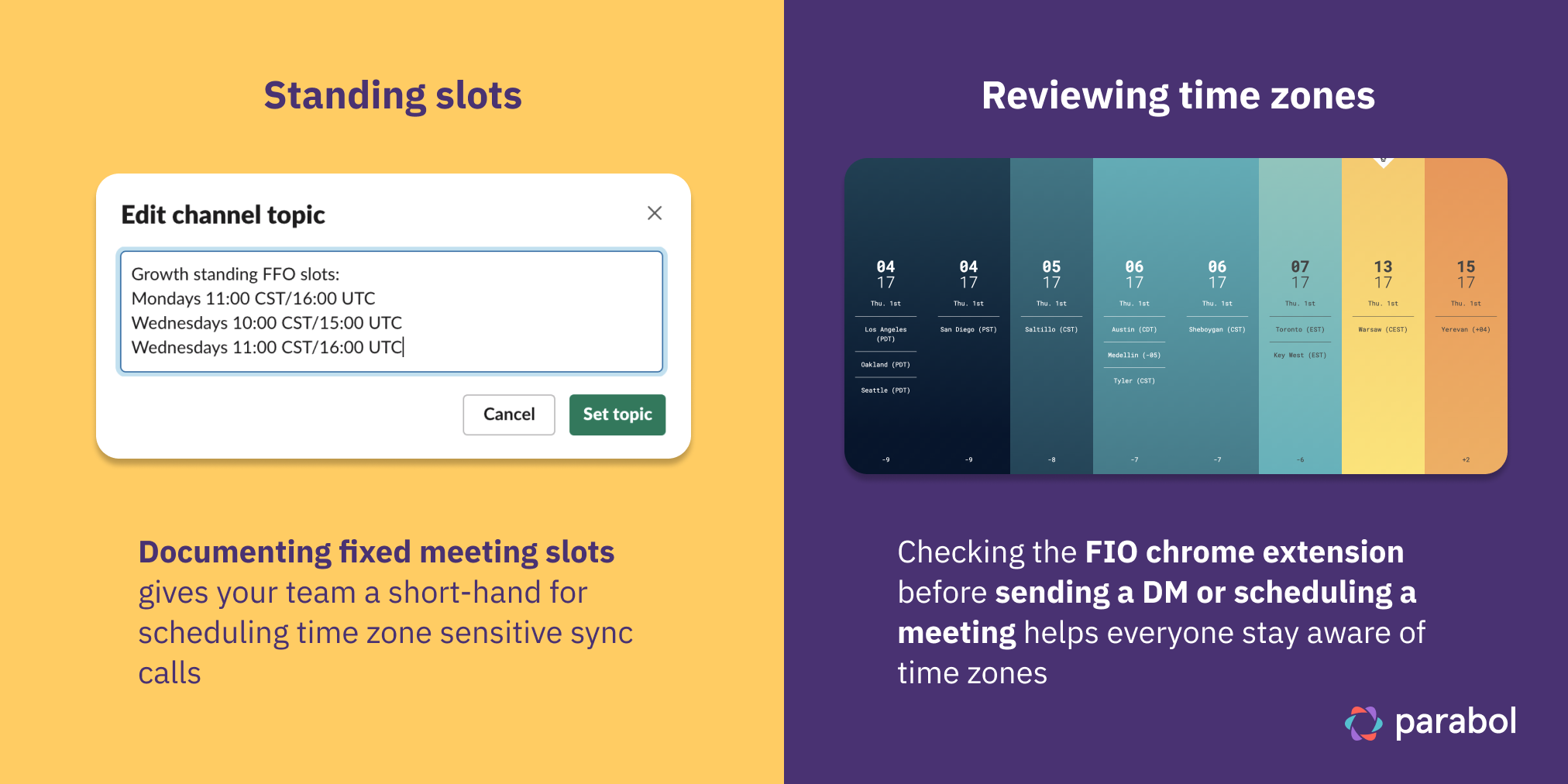
3. Explicitly showing care and empathy 🤗
When you can’t see people face to face, you need to be more intentional about acting with care and empathy. Humans have evolved to read body language. And when working remotely, we don’t have that additional data to hand. Where in an office you might have seen someone getting visibly angry or crying in the bathroom, but remote work hides all of those things from you.
So try explicitly asking team-mates how they are doing, instead of simply making assumptions. One easy way to do this is by asking an icebreaker in Slack at the start of your day, or in your meetings.
We like to ask “how does it feel to be you right now” to get a deeper sense of how someone is doing and put ourselves in another’s shoes. This is not only a helpful process for building stronger bonds with team members, but it also helps develop your empathy muscle when dealing with customers.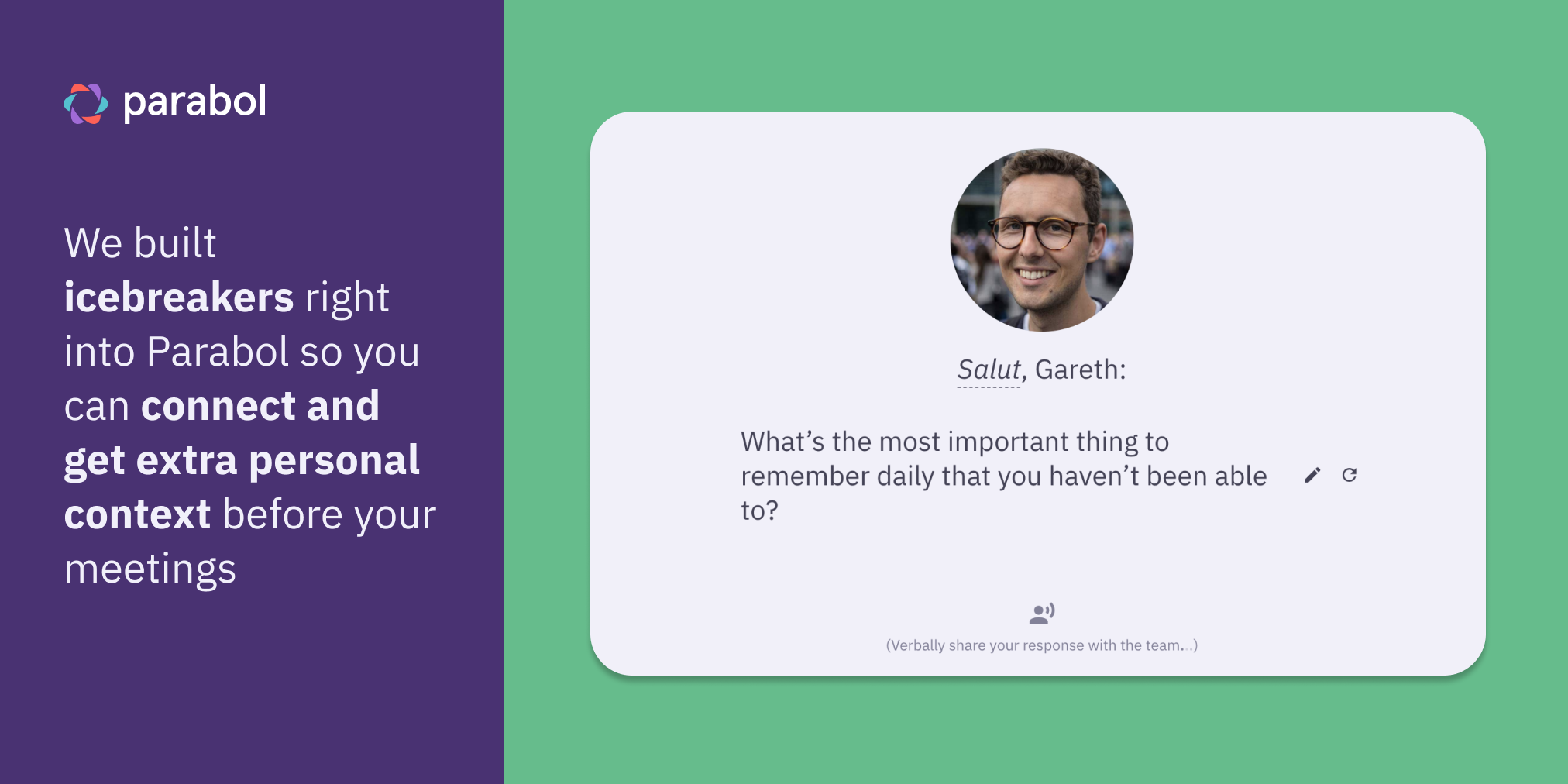
4. Working asynchronously 🏓
One concept that props up remote work is asynchronous work. It’s become a real buzzword, and it’s easy to see why. Whereas the office was full of distractions, an async working culture seeks to eliminate them. When working asynchronously, everyone is doing their thing in their own time, pitching in when it’s convenient for them, wherever they are in the world.
The habit of async work has also encouraged the use of different technologies like Loom for show and tell videos or Figma for sending a quick sketch or diagram. We also rely heavily on other tools like Gifox for creating gifs, Grain for recording and sharing clips of video calls, and Hugo for documenting calls. When teams don’t need to constantly sync up with one another, they can save a huge amount of time.
Working async allows your people to eliminate distractions and find flow. And that’s one of the most powerful gifts you can give to employees who have a passion for what they are doing.
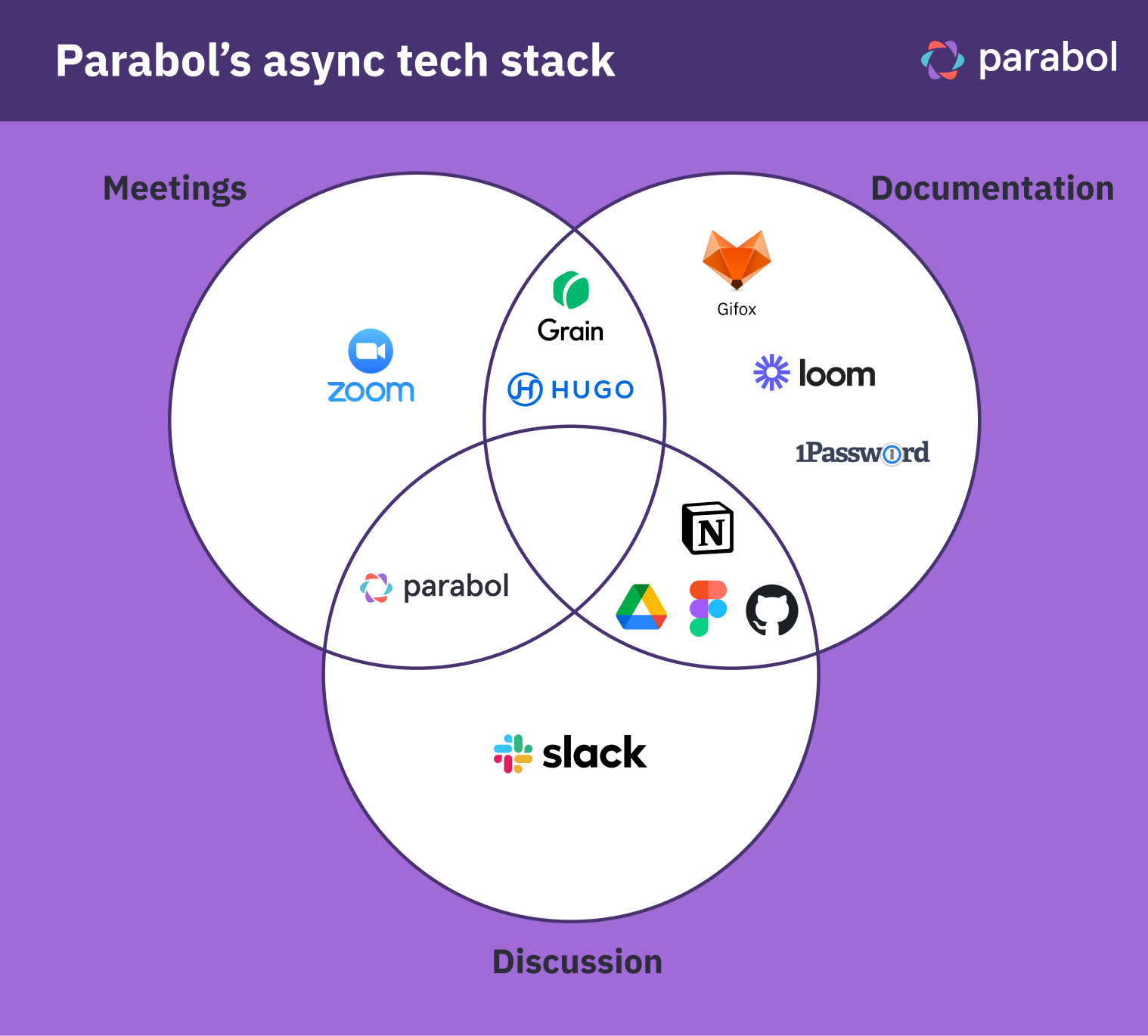
5. Documenting (almost) everything 📝
When you’re working remotely it’s not always possible to tap your colleague on the shoulder and ask how to do something. That’s why documentation matters. Writing everything down to share later is critical for teams that want to save time and have more meaningful conversations.
Just learned how to do something new? Write a short FAQ for the next person who comes along. Finally completed your recent marketing experiment? Document the results for everyone to learn from.

Our Growth team Notion is full of helpful FAQs to consult.
Not only does it help everyone serve themselves, but it democratizes knowledge in your organization, helps people to unblock themselves if they’re stuck on something, and prevents you getting distracted with questions from those very people who are stuck. It also makes onboarding new team members a whole lot easier when they can spend their own time reviewing the way your company does things, what you’ve learned, and even your company lore.
At Parabol we’ve taken this one step further, documenting our company’s journey every week in a blog we call the “Friday Ship”.
Think of documentation as an investment for the future. One hour documenting a process in the present, could save multiple hours explaining and re-explaining a process in the future.
6. Using a central (virtual) work hub 🗃
We’ve already discussed the importance of documentation. But documentation is no good unless you’re storing all your learnings and FAQs for your whole organization to browse.
Remote companies need to build a central (virtual) work hub where everyone can store all that important documentation.
We use Notion, but you could also try Slab. Not only does a central wiki or documentation hub empower async work, it makes life easier for all employees by giving everyone access to information. It prevents people hoarding or leveraging information for personal status and gives more people the opportunity to solve problems themselves.
7. Escalation pathways 👣
Sometimes there will be a hole in your documentation and one of your team members is going to get stuck. The only thing to do is reach out and ask. An escalation pathway gives you a clear idea of what your next step should be and who you may need to contact.
Sometimes that next step is accept the problem and try to move forward (documenting that fact for everyone else to know). In other cases, it might mean talking to a specific person, consulting an additional resource, or something else entirely.
The key is to have the path documented so people don’t default to wasting time reaching out to the wrong person. Even if you don’t have answers documented, having roles or escalation pathways written down helps everyone know who to contact about a specific thing.
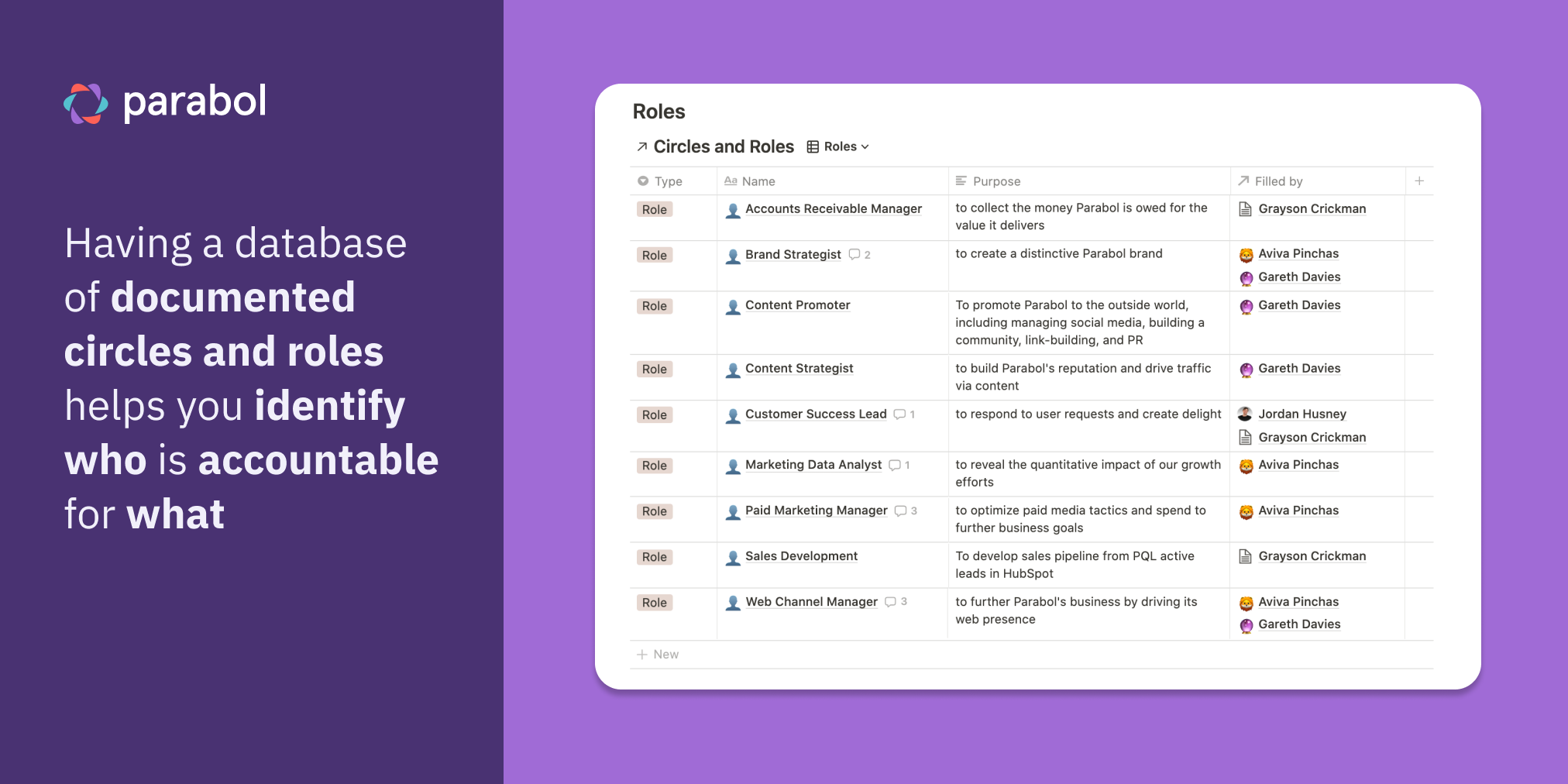
Borrowing from Holocracy, Parabol is organized according to circles, roles, and accountabilities that are documented in our centralized work hub. This allows anyone to see who is responsible for what role and who to reach out to on a specific thing.
8. Focusing on outcomes > face-time 📥
Ever worried about appearing inactive as a Slack or Teams message comes in? Ever felt worried about being the first one to leave the office? Both of these fears are evidence of a toxic form of presenteeism that signals a lack of trust on the part of employers.
Effective remote work relationships and built on a foundation of trust. We trust that our colleagues will take care of their responsibilities. It doesn’t matter if they decide to take a midday run, or don’t reply to our messages immediately, because we know they are capable of managing their own time.
Evaluating on outcome over presenteeism is a more sensible way of judging someone’s contributions. Not only does it let people work when they are their most focused, but it also makes people feel in control of their own work.
Using time tracking software or evaluating based on how quickly people respond to IMs or emails not only tells employees they aren’t trusted, but fails to track the most important metric – what a person contributes to the team.
When an employee knows they are being measured on outcome, attempts to appear busy simply go away. All that effort put into performing can be spent on producing better results for everyone. Even if your company is set to go back to the office, lean on the ledger of trust you’ve built up during 2020’s work-from-home experiment to focus on outcomes over facetime.
9. Flexibility at work 🏃
This one’s for all you early birds and night owls out there! Being able to choose when your most productive hours are is great for job satisfaction and helping employees find flow. Further, it allows for real life to happen: you can step out for 20 minutes if there’s an errand to run, you feed the kids, or because the plumber arrived… 99.9% of the time it will have no impact on your work.
And for that 0.1%, plan ahead if you can just so people know you’re not available. When companies offer flexibility and give employees the chance to choose (within reason) when they want to work, you build a more loyal and engaged workforce.
10. Decision-making frameworks ✅
When your team is working remotely or is distributed around the world, how do you make decisions? The first impulse might be to jump on a video call and talk it out. But that can quickly turn into a directionless soup of ideas that’s difficult to take forward. Working on a written proposal and having an async decision-making process to govern that proposal (such as this one we built at Parabol) will help you put structure into your decision-making processes and give everyone the chance to contribute, no matter where they are in the world.
If you haven’t already adopted a clear decision-making process perhaps this is something new to try, even if your team goes back to the office. Not sure where to start? Or not clear what the benefits are? Take a look at our guide to setting up a decision-making bot in Slack or check out what the folks over at Murmur are building.
11. Working in the open 👀
In an office environment working in the open might have meant taking your laptop out to the office veranda. But in a remote environment, working ‘in the open’ means being descriptive and transparent about the tasks you are working on and sharing results in public channels for all to see. This habit increases transparency and trust – not to mention that it makes it easier to see who is working on what outcomes.
Working in the open can go all the way from having kanban boards viewable by the whole organization, all the way through to openly discussing findings in public Slack or MS Teams channels. It can feel awkward to do that at first, but it helps bring other perspectives into your work and gives the whole team an ambient understanding of what you’re working on.
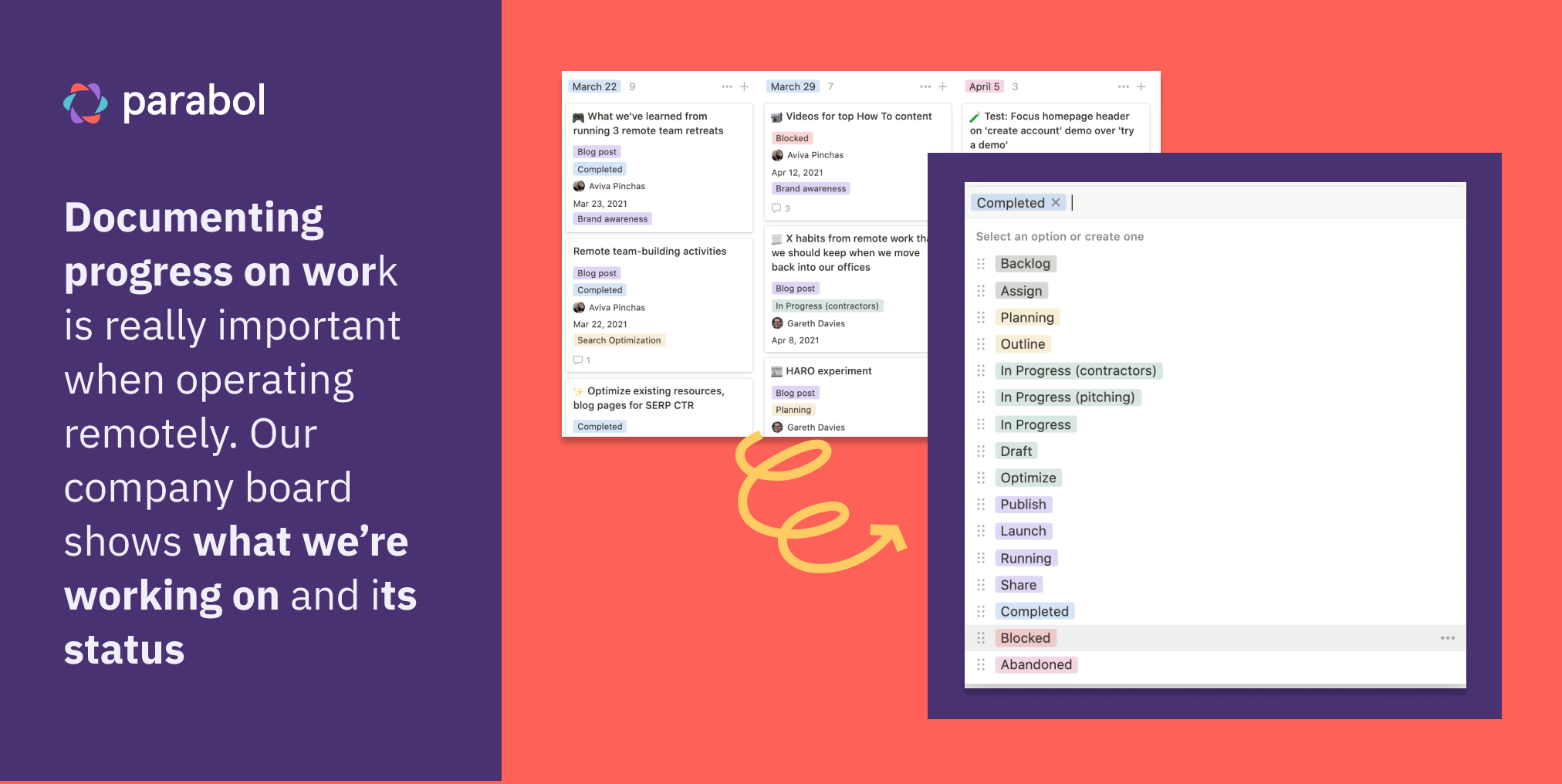
12. Embracing memes, smileys, and GIFs 👻
When we communicate in person we have a whole host of additional context derived from body language, whether it’s tone of voice, how someone is sitting, eye contact. In a remote environment we mostly have… well, just text and the odd video call. Using memes, GIFs, and smileys is a helpful practice for indicating your mood or explicitly showing that your message was meant in a happy or lighthearted tone.
Over time, memes, GIFs and smileys also take on their own deeper cultural meaning and bind people together. Simply put, visual assets make communications warmer and help to explain the emotional place a message is coming from. Even reacting with an emoji to a Slack or MS Teams message helps your team feel more like humans connecting to one another. They add that extra sprinkling of joy and magic.

13. Assuming positive intent 💌
Assuming positive intent means considering that everyone in your organization is pulling towards the same goals and acting in the spirit of making things better. So when someone gives you that piece of feedback that hits a sensitive spot, it’s helpful to take a step back and realise that they’re doing it with positive intent, because they want to make your work better.
This is a remote work habit that can be difficult to get started with and hard to remind ourselves of too, because the times when we need to assume positive intent are the ones where we may feel personally threatened or annoyed by something.
But it can help avoid fights and unnecessary tension building up. Practicing empathy and assuming positive intent doesn’t mean you can’t be assertive and disagree with others, it just means that you take a step back and consider where they are coming from first.
14. Defaulting to oversharing 📣
If you’re working remotely and no-one’s heard from you in a few days, it can be really unsettling. It’s important when remote that everyone still feels connected. One way to stay connected is to not be shy about sharing what you’re working on and how it’s going.
If you’re not sure whether to share a finding or an update, play by the Nike rule: Just do it. By the same token, encourage new hires to ask as many questions as they need to after exhausting your documentation so you can form a bond and efficiently unblock each other.
For issues that require a more detailed conversation or are less urgent, you can log issues in the agenda of your next 1:1 meeting or check-in meeting.
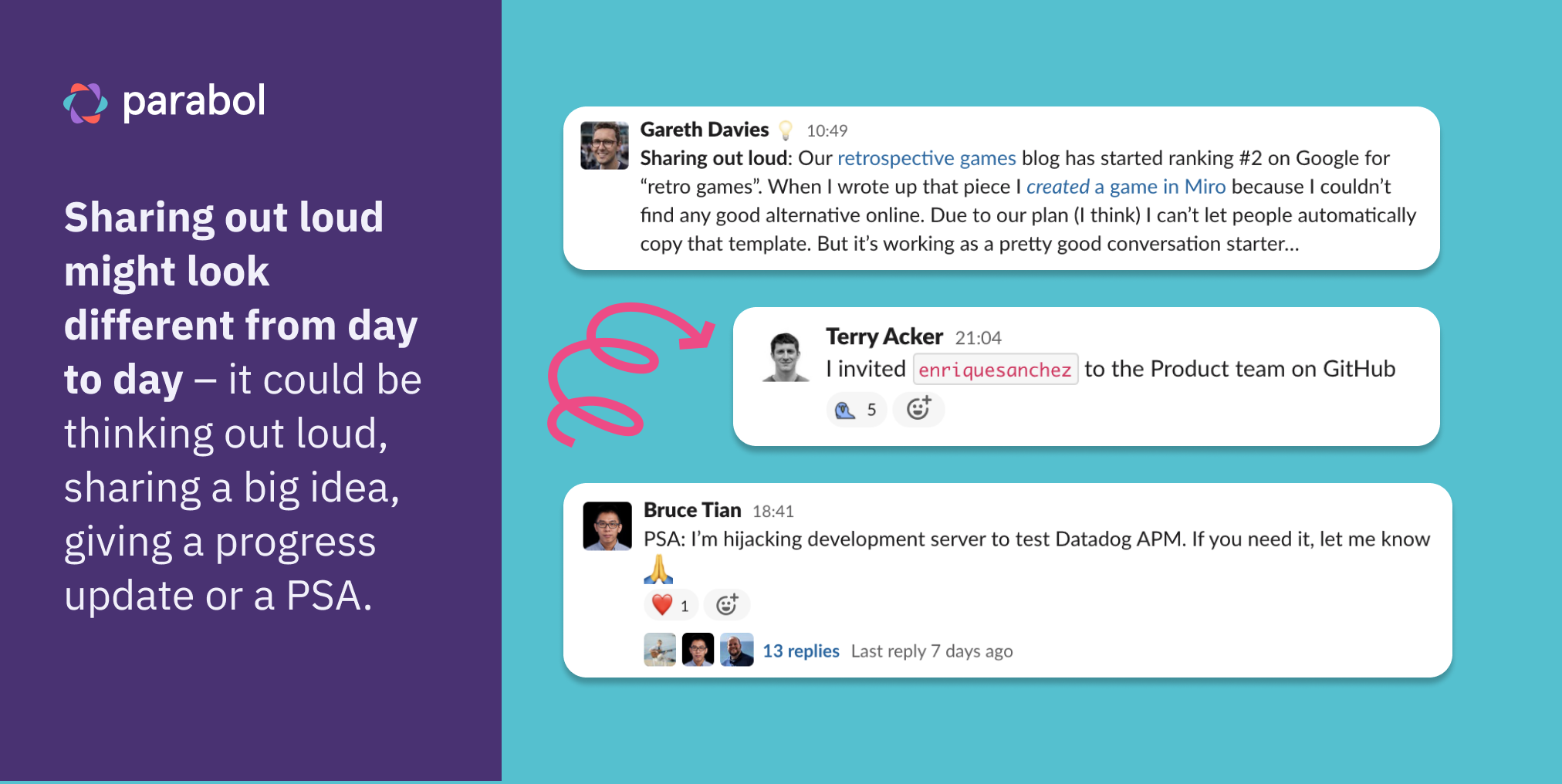
15. Creating social spaces 🕹
Those people you work with day in and day out are humans too, you know. And humans need contact. Buffer’s State of Remote Work report has shown that loneliness and isolation are very real feelings remote workers experience.
When you’re all working from your own spaces, in different parts of town, in different cities, states, or even countries, you can’t get that mid-morning coffee to catch up, or stop for a beer after work. You need to be more intentional about creating time to socialize.
And while we all know ‘organized fun’ is an oxymoron, just setting up a social 1:1 every week with a team-mate or having an all team or all company social hour each week to play some games or chat should be encouraged! At Parabol we hold a weekly Fika call to catch up and have a #Fika channel to share fun things we’ve found or personal updates.
16. Showing up and sharing out 💡
Remote work gives us a unique insight into peoples’ lives. You’ve no doubt met all your colleagues’ pets at this stage and maybe some of their kids too! And while those encounters might happen by serendipity (even a closed door won’t stop a child on a mission), the onus is on employees to share their personal context.
That could mean being open about difficult things going on in your life – a family member’s surgery or a natural disaster. But also sharing personal projects. We’ve had our eyes glued to Slack recently after Terry from the Parabol team started building a hut for his chickens. In the absence of physical meetings and idle chat, be intentional about showing up and sharing out what’s going on in your life.
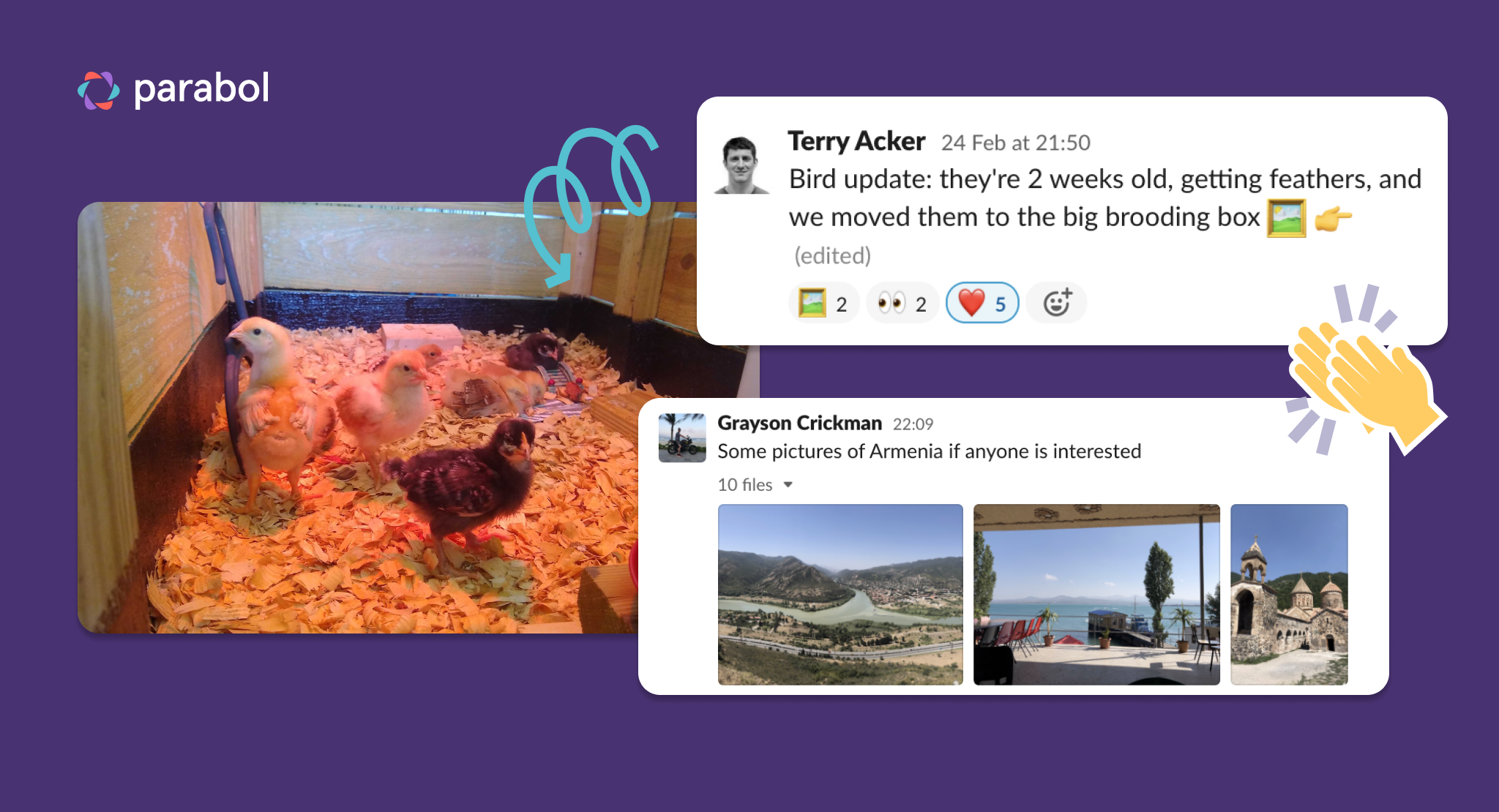
17. Experimenting with work 🧪
When you transition to remote work there’s a lot of experimentation that takes place. Not just with where you set up your desk, but with what tools you use to get work done, how you communicate with your team members, and much more. It forces people to rethink work from first principles and ask: what’s the most effective way of doing this thing.
The pandemic year forced a lot of us to rethink how work… works. And many teams found themselves trying out new tools and becoming all around more resilient and more welcoming of change. Keeping up the energy to experiment with new things and constantly be re-thinking the way we work together is perhaps the most important lesson we can take out of remote work experiences.
Unproductive remote work habits to stop
There are a lot of benefits to be derived from remote work. But it isn’t all good news. It’s easy to pick up some bad habits that are important to stop whether you’re working remotely or going back into the office. Here are three habits that definitely don’t need to stick around.
1. Never seeing your team in-person 😢
Remote work does not mean you can’t see each other in person. While we have gone through our fair share of remote retreats and learned a lot along the way, companies should think about whole-company get-togethers, if feasible. At the very least, companies should encourage and pay for employees to co-work together from time to time if they live in the same area.
2. Debating ‘all-remote’ versus ‘all-office’ 🤔
Remote work does not exist in opposition to office work. Companies and employees can choose the mix of remote and office work that suits them best. The future of work is most likely hybrid. Meaning some people in the office and some remote. Or people doing a bit of both.
3. Letting boundaries erode 😫
Year after year, difficulty unplugging from work is cited by people as the biggest challenge of remote work. And it’s a bad habit many of us have picked up during the remote work of 2020. Whether you stay remote or go back to the office, make sure to put those boundaries between life and work in place. Consider having a separate room you work in, doing a ‘commute replacement’ to work up to and wind down from work, or scheduling a fixed start and end time to your day.
Work habits are about finding what works and making it stick
Remote work saw the world embracing a lot of amazing habits that in many cases improved the way we work. And while it hasn’t been everyone’s cup of tea there are lessons to take from every experiment.
As you think about what works for you (both as a person as for your company), first think about what you’re trying to achieve and then work backwards to decide what mix of remote and co-located work will get to your end goals as efficiently as possible.
From there, introduce new habits or reinforce old ones to help you reach your goals. And don’t forget that any habit is inherently an experiment. If you try something and it works, great! If there’s some room for improvement, don’t be afraid to customize it for your needs.








